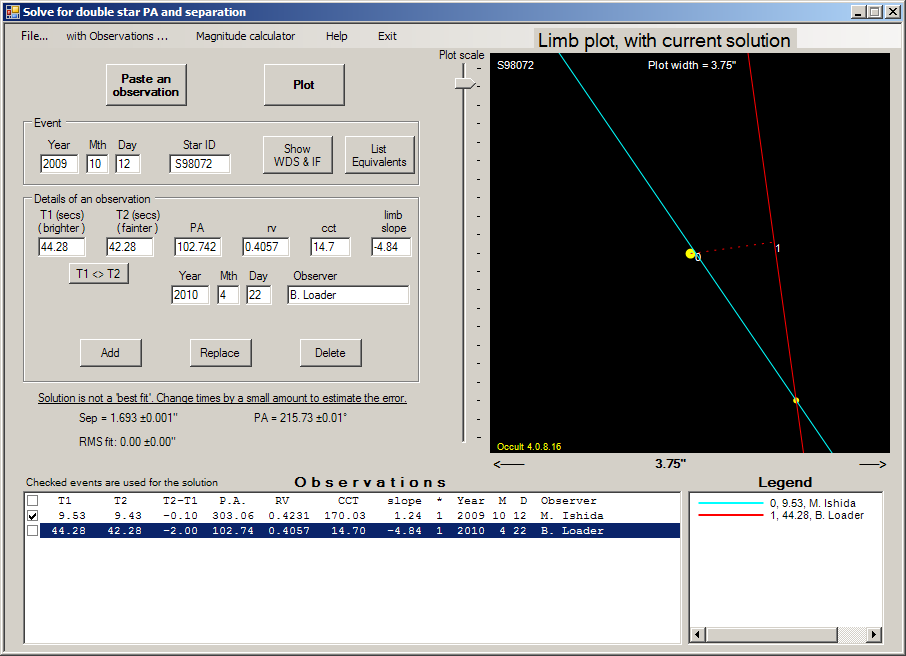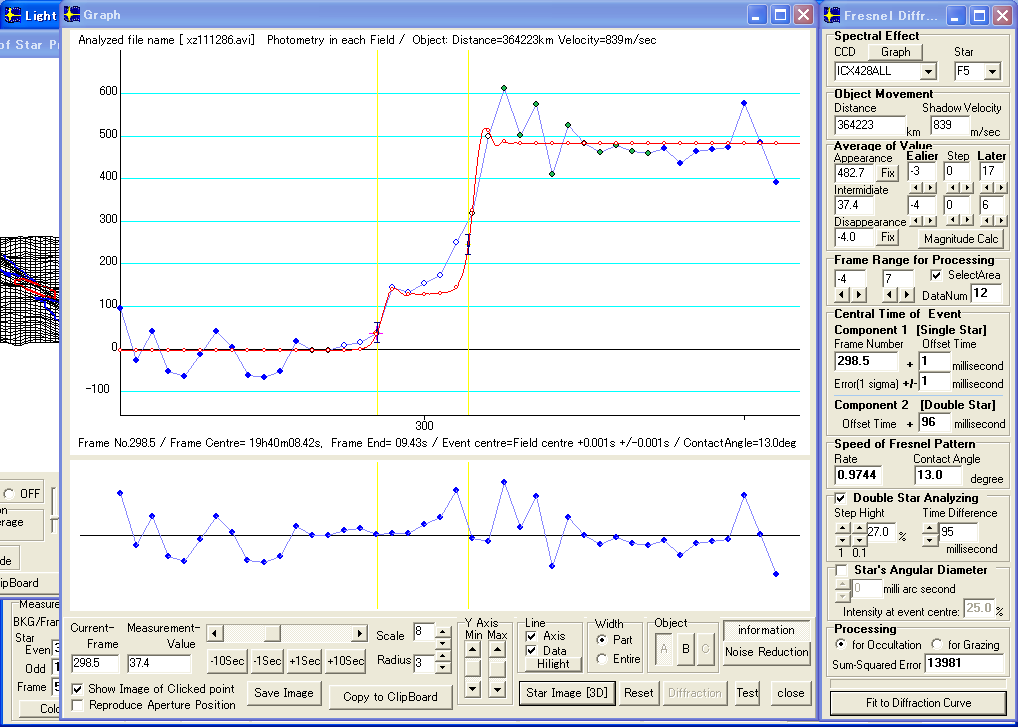Observation and analysis of SAO98072 in Oct 12, 2009 (UTC)
Oct. 17, 2009
Reviced May 03, 2010
Kazuhisa Miyashita
Solution of astrometric analysis
Two or more observations make astrometric solution of double star's components possible.
A confirmation observation had been made by Brian Loader who is coodinator for observation of double star occultation.
Brian analyzed his observation with Isida-san's observation, and obtained a good solution. See below.

Brian wrote:
On April 21 I observed R1174 a double previously observed by Ishida-san on
2009 October 11 and on April 22 S 98072 observed by Ishida-san 2009 October 12.
This has enabled me to calculate a solution for these doubles. Attached
are the solutions as generated by Occult.
The solution for S98072 is 1.69" at PA 215.7 deg,
predicted was 1.3" at PA 223.7 deg for both events.
Observed magnitude differences:
S98072 Ishida 0.75, Loader 0.72, predicted 0.30
Please pass on the result to Ishida-san with my thanks. It is good to be
able to combine results from Japan and New Zealand in this way.
Doublestar Report to IOTA coordinator
2009 Oct 12 at 19h 40m
Star = S98072
Observer = M. Ishida
Telescope = 30.0cm at 135 56 33.6 35 6 22.3
Double star details from the XZ catalogue
Star is the primary of the following pair
A 2546 1913 1991: 215.0 222.0: 0.700 1.200: 9.79 10.09: S 98072 X111286
Observation details
Star Mag = 9.74
Event = R D
PA = 303.062
AA = 289.304
l = 0.574
b = 1.633
RV = 0.4231
CCT = 170.03
T1 = 9.53
T2-T1 = -0.10
|
|---|
Occultation timing report
Place name Moriyama, Shiga, Japan
Representative Masayuki Ishida
TA CED 30 300 +13556xx.x +3506xx.x 84 xx.xM
OA M. Ishida
20091012194009.43 X111286 RD EG G0.02 1 W 22 AA
20091012194009.53 S 98072 RD EG G0.02 1 E0.05 T221 AA
|
|---|
Light curve

Photometry
- Estimation of Magnitude of Doublestar Components -
Assuming magnitude of Pair is 9.74 Mag.
Estimated Magnitude
First Event : 10.98 +/- 0.09 Mag.
Second Event : 10.16 +/- 0.05 Mag.
- Measurement ---------------------------------------
Luminous Intensity derived from Limovie analysis
Average Stdv n
Combined : 482.6 60.9 48
Step : 151.5 16.9 4
Background: -4.7 46.5 40
Noise Level (N/S)
Upper Lower
First event: 0.1082 0.2980
Second event:0.1839 0.0510
|
|---|
Comment and explanation
Ishida-san sent his video file of SAO98072 and XZ111286 event to me. I had analyzed it using Limovie and found a small step which has four fields duration and gradual increasing on the light curve. The details of this star on WDS is
Catalogue details
XZ 13255 = SAO 98072
RA = 8 43 39.9117 PM = 0.00113s
Dec = 16 53 54.988 PM = -0.0097"
Mv = 9.74, Mb = 10.16, Mr = 9.52 Spectrum __ Approx dia. .0001"
XZ 111286
RA = 8 43 39.9117 PM = 0.00113s
Dec = 16 53 54.988 PM = -0.0097"
Mv = 10.03, Mb = 10.59, Mr = 9.74 Spectrum __ Approx dia. .0001"
Star is the primary of the following pair
Name Cmpt Yr1 Yr2: PA1 PA2 : Sep1 Sep2 : Mag1 Mag2: #1 #2 mean
A 2546 1913 1991: 215.0 222.0: 0.700 1.200: 9.79 10.09: S 98072 X111286
WDS Discoverer codes
A Aitken, R.G.
|
|---|
The light curve shows that the second event has gradual light change.
However, the RV (=0.4231) cannot make such gradual change. And also, approx diameter is too small to make this light curve. See Figure 2.
So, I tried the diffraction fitting and obtained the result as attached file (FittingForGradualChange.png).
As a result of this, the residual of fitting becomes minimum at the time difference is 0.032 seconds.
It is no enough evidence that this star is double. However, it is thought that
SAO98072 became a candidate of a closed double which should be investigated in the future.
Diffraction fitting





